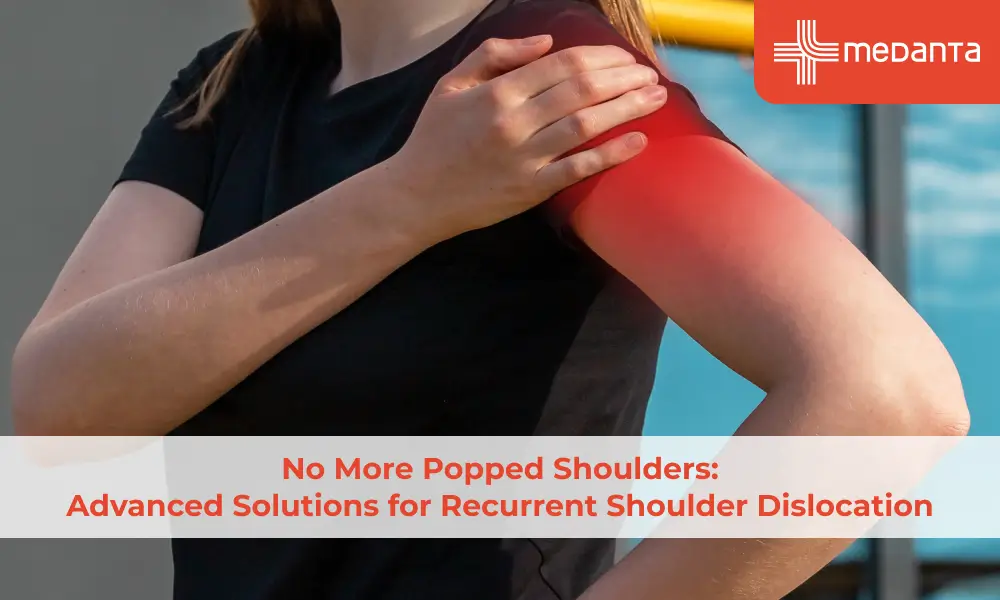No More Popped Shoulders: Advanced Solutions for Recurrent Shoulder Dislocation

TABLE OF CONTENTS
Shouldеr joіnts arе incrеdibly mobile and adaptablе, enabling us to participate in a wide variety of activities. But unfortunately, this flexibility also makes them susceptible to injury, particularly dislocation.
Recurrent shoulder dislocation, characterised by repeated episodes of the shoulder joint slipping out of its socket, can significantly impact an individual's daily life and overall well-being. A recent study published in the Journal of Shoulder and Elbow Surgery found that surgical stabilization techniques resulted in a 90% success rate in preventing recurrent shoulder dislocation
In this blog, we'll explore the causes of recurrent shoulder dislocation, recurrent shoulder dislocation surgery, discuss chronic dislocation of shoulder, and delve into advances in treatment techniques.
Recurrent shoulder dislocation refers to the repeated occurrence of the shoulder joint slipping out of its socket, often as a result of trauma or underlying anatomical factors. Unlike acute dislocation, which is a one-time event, recurrent dislocation presents a pattern of instability and can severely impact an individual's quality of life.
Common symptoms of recurrent shoulder dislocation include intense pain, swelling, limited range of motion, and a feeling of the shoulder "popping out" or "giving way."
Causes of Recurrent Shoulder Dislocation
Traumatic Causes
Trauma, such as falls, sports accidents, or car accidents, is a common cause of recurrent shoulder dislocation.
When the shoulder experiences a forceful impact or is forcefully moved beyond its normal range of motion, the structures supporting the joint, including ligaments and tendons, can become damaged. Once the joint has dislocated once, there is an increased risk of future dislocations.
Anatomical Factors
Certain anatomical factors can predispose individuals to recurrent shoulder dislocation. These include a shallow shoulder socket, known as glenoid dysplasia, or loose ligaments that fail to adequately stabilise the joint. These anatomical abnormalities can create an unstable shoulder joint, making it more prone to dislocation.
Muscle Imbalance and Weakness
The shoulder joіnt is stabіlizеd іn large part by the rotator cuff muscles. Imbalances or weakness in these muscles can lead to shoulder instability and recurrent dislocation.
Imbalances can occur due to overdeveloped muscles on one side of the shoulder, inadequate muscle strength, or poor coordination between different muscle groups.
Overuse and Repetitive Strain
Engaging in repetitive motions or overusing the shoulder joint can strain the surrounding structures, leading to instability and recurrent dislocation. Activities that involve repetitive overhead motions, such as throwing, swimming, or weightlifting, can contribute to the development of shoulder instability over time.
Recurrent Shoulder Dislocation Surgery
Conservative Treatments
In some cases, conservative treatments may be attempted before considering surgical intervention. These can include physical therapy, rehabilitation exercises, and lifestyle modifications to avoid activities that provoke shoulder instability.
However, it's important to note that conservative treatments may not provide long-term stability for individuals with recurrent shoulder dislocation.
Surgical Interventions
When conservative treatments fail to provide lasting relief, surgical intervention may be necessary to restore stability and prevent further dislocations. The choice of surgery depends on the severity of the instability, underlying structural damage, and the patient’s lifestyle needs.
Arthroscopic Stabilisation
Arthroscopic stabilisation is a minimally invasive recurrent shoulder dislocation surgery used to repair and stabilise the shoulder joint. During the procedure, small incisions are made, and a tiny camera, known as an arthroscope, is inserted to visualise the inside of the joint.
Through additional small incisions, specialised instruments are used to repair damaged ligaments, tighten loose structures, or reattach torn tendons. This technique offers several benefits, including shorter recovery time, reduced postoperative pain, and improved cosmetic outcomes.
Open Stabilization Procedures
In some cases, open stabilisation procedures may be necessary, particularly for individuals with more complex or severe shoulder instability. Open procedures, such as the Latarjet procedure or Bankart repair, involve larger incisions to directly access and repair the damaged structures.
The Latarjet procedure involves transferring a piece of bone from the patient's coracoid process to the front of the shoulder socket, providing additional stability. Bankart repair involves reattaching and tightening the torn or stretched ligaments in the shoulder joint.
Advances in Treating Recurrent Shoulder Dislocation
Biological Augmentation
In recent years, there have been advancements in using biological materials or tissue grafts to augment shoulder stabilisation procedures. These techniques aim to enhance the healing process and provide additional support to the shoulder joint.
Biological augmentation may involve using substances such as dermal allografts or synthetic scaffolds to reinforce weakened or damaged ligaments. While still emerging, these techniques show promising results in reducing the risk of recurrent dislocation.
Rehabilitation and Physical Therapy
Rehabilitation and physical therapy play a crucial role in restoring shoulder stability and preventing recurrent dislocation. A tailored rehabilitation program focuses on strengthening the rotator cuff muscles, improving joint proprioception, and enhancing overall shoulder function.
Physical therapists use various exercises, including a range of motion exercises, resistance training, and stability drills, to address muscle imbalances, improve shoulder mechanics, and promote long-term joint stability.
Chronic Dislocation of the Shoulder
Definition and Symptoms
Chronic dislocation of the shoulder refers to a long-standing condition in which the shoulder remains partially or fully dislocated. Unlike recurrent dislocation, chronic dislocation may not spontaneously reduce or relocate itself.
Individuals with chronic dislocation often experience persistent pain, limited range of motion, muscle weakness, and functional limitations in daily activities.
Treatment Options
The treatment of chronic shoulder dislocation depends on factors such as the severity of damage, patient age, and functional goals. Surgical options for chronic dislocation may include joint resection, arthroplasty, or shoulder replacement surgery.
Joint resection includes removing a portion of the joint, reducing pain and improving range of motion. Arthroplasty or shoulder replacement surgery may be considered for cases with extensive damage, where the joint is reconstructed using artificial components.
Conclusion
Recurrent shoulder dislocation can significantly impact an individual's quality of life, but there are effective treatment options available. Understanding the causes of recurrent shoulder dislocation surgery, exploring recurrent shoulder dislocation surgery like arthroscopic stabilisation or open procedures, and embracing advancements in biological augmentation techniques can provide lasting relief and restore shoulder stability.
It is crucial to seek professional medical advice to determine the most appropriate treatment approach based on individual circumstances. With the right intervention and a comprehensive rehabilitation program, individuals with recurrent shoulder dislocation can bid farewell to popped shoulders and regain a stable and functional shoulder joint.
If you face recurrent shoulder dislocations very frequently, consult an expert orthopaedic doctor for proper treatment.






